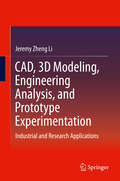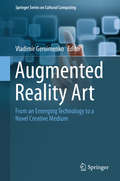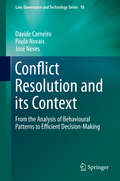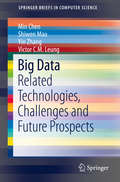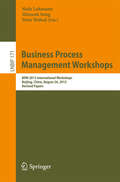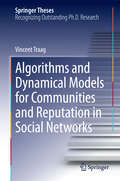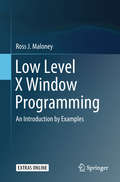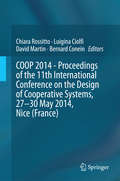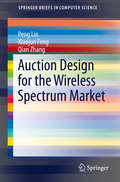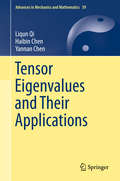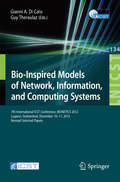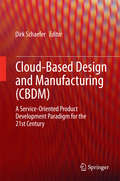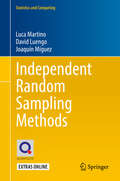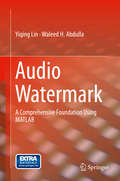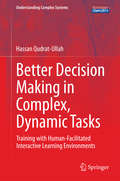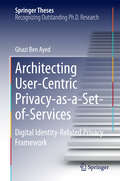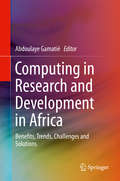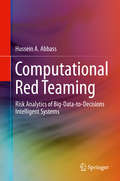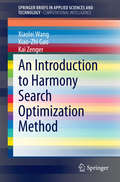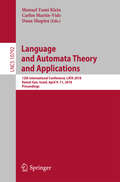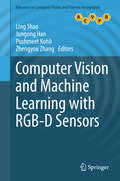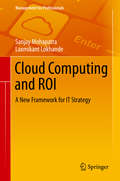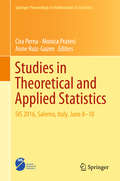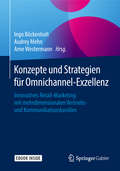- Table View
- List View
CAD, 3D Modeling, Engineering Analysis, and Prototype Experimentation: Industrial and Research Applications
by Jeremy Zheng LiThis succinct book focuses on computer aided design (CAD), 3-D modeling, and engineering analysis and the ways they can be applied effectively in research and industrial sectors including aerospace, defense, automotive, and consumer products. These efficient tools, deployed for R&D in the laboratory and the field, perform efficiently three-dimensional modeling of finished products, render complex geometrical product designs, facilitate structural analysis and optimal product design, produce graphic and engineering drawings, and generate production documentation. Written with an eye toward green energy installations and novel manufacturing facilities, this concise volume enables scientific researchers and engineering professionals to learn design techniques, control existing and complex issues, proficiently use CAD tools, visualize technical fundamentals, and gain analytic and technical skills. This book also: · Equips practitioners and researchers to handle powerful tools for engineering design and analysis using many detailed illustrations · Emphasizes important engineering design principles in introducing readers to a range of techniques · Includes tutorials providing readers with appropriate scaffolding to accelerate their learning process · Adopts a product development, cost-consideration perspective through the book's many examples
Augmented Reality Art: From an Emerging Technology to a Novel Creative Medium (Springer Series on Cultural Computing)
by Vladimir GeroimenkoThis is the first ever book on augmented reality art. It is written by a team of world-leading artists, researchers and practitioners, pioneering in the use of augmented reality technology as a novel artistic medium. The book explores a wide range of major aspects of augmented reality art and its enabling technology. It is intended to be a starting point and essential reading not only for artists, researchers and technology developers, but also for students (both graduates and undergraduates) and everyone who is interested in emerging augmented reality technology and its current and future applications in art.
Conflict Resolution and its Context: From the Analysis of Behavioural Patterns to Efficient Decision-Making (Law, Governance and Technology Series #18)
by Davide Carneiro Paulo Novais José NevesThis book studies how technological solutions can be used to alleviate the current state of legal systems, with their clogged up courtrooms and inefficient conflict resolution methods. It reviews the shortcomings and disadvantages of traditional and alternative conflict resolution methods and turns to Artificial Intelligence for problem-solving techniques and solutions. The book is divided into four parts. The first part presents a general and systematic analysis of the current state of the legal systems, identifying the main problems and their causes It then moves on to present UM Court: a framework for testing and prototyping conflict resolution services. This framework was developed with the objective of using Artificial Intelligence techniques to build a service environment for conflict resolution. The third part of the book takes a step into the future by analyzing the use of Intelligent Environments in the support of conflict management and resolution. It describes the approach taken and the experiments performed in the Intelligent Systems Lab of the University of Minho. The final part of the book contains the conclusions and shows the potential advantages of the use of Intelligent Environments as a way to implement better conflict resolution procedures (virtual or real), in which all the participants have access to more and better information and are able to take better informed decisions.
Big Data: Related Technologies, Challenges and Future Prospects (SpringerBriefs in Computer Science)
by Min Chen Shiwen Mao Yin Zhang Victor C. M. LeungThis Springer Brief provides a comprehensive overview of the background and recent developments of big data. The value chain of big data is divided into four phases: data generation, data acquisition, data storage and data analysis. For each phase, the book introduces the general background, discusses technical challenges and reviews the latest advances. Technologies under discussion include cloud computing, Internet of Things, data centers, Hadoop and more. The authors also explore several representative applications of big data such as enterprise management, online social networks, healthcare and medical applications, collective intelligence and smart grids. This book concludes with a thoughtful discussion of possible research directions and development trends in the field. Big Data: Related Technologies, Challenges and Future Prospects is a concise yet thorough examination of this exciting area. It is designed for researchers and professionals interested in big data or related research. Advanced-level students in computer science and electrical engineering will also find this book useful.
Business Process Management Workshops: BPM 2013 International Workshops, Beijing, China, August 26, 2013, Revised Papers (Lecture Notes in Business Information Processing #171)
by Niels Lohmann Minseok Song Petia WohedThis book constitutes the refereed proceedings of nine international workshops held in Beijing, China, in conjunction with the 11th International Conference on Business Process Management, BPM 2013, in August 2013. The nine workshops comprised Business Process Intelligence (BPI 2013), Business Process Management and Social Software (BPMS2 2013), Data- and Artifact-Centric BPM (DAB 2013), Decision Mining and Modeling for Business Processes (DeMiMoP 2013), Emerging Topics in Business Process Management (ETBPM 2013), Process-Aware Logistics Systems (PALS 2013), Process Model Collections: Management and Reuse (PMC-MR 2013), Security in Business Processes (SBP 2013) and Theory and Applications of Process Visualization (TAProViz 2013). The 38 revised full papers presented were carefully reviewed and selected from 74 submissions.
Algorithms and Dynamical Models for Communities and Reputation in Social Networks (Springer Theses)
by Vincent TraagA persistent problem when finding communities in large complex networks is the so-called resolution limit. This thesis addresses this issue meticulously, and introduces the important notion of resolution-limit-free. Remarkably, only few methods possess this desirable property, and this thesis puts forward one such method. Moreover, it discusses how to assess whether communities can occur by chance or not. One aspect that is often ignored in this field is treated here: links can also be negative, as in war or conflict. Besides how to incorporate this in community detection, it also examines the dynamics of such negative links, inspired by a sociological theory known as social balance. This has intriguing connections to the evolution of cooperation, suggesting that for cooperation to emerge, groups often split in two opposing factions. In addition to these theoretical contributions, the thesis also contains an empirical analysis of the effect of trading communities on international conflict, and how communities form in a citation network with positive and negative links.
Modernizing the Academic Teaching and Research Environment: Methodologies And Cases In Business Research (Progress in IS)
by Jorge Marx Gómez Sulaiman MouselliThis book constitutes a valuable manual for young and seasoned business researchers alike, and provides a comprehensive summary for the whole research journey. It is a must-read for all researchers who need to understand the basics of business research, from identifying research topics, to planning and organizing the research process, and selecting the most appropriate methodology for the topic at hand. This book also provides insights on how to avoid common pitfalls in business research and outlines the research skills needed to write a fine piece of research. In order to capture the innovative element of research, the book also highlights methods for thinking outside the box. It also stresses the importance of respecting ethics while conducting business research. Lastly, it presents important cases and provides hands-on training for preparing survey tools. Readers looking to master business research won’t want to miss out on this unique and insightful book.
Low Level X Window Programming: An Introduction By Examples
by Ross J. MaloneyThis is the missing X Window book. While others have shown what the X Window system has available, this book shows how to convert this potential into working tools to fulfil your visualisation needs. It is of the show-me class of books. The majority of the book covers Xlib, although a short coverage of Xcb is also given. Included are: . The relationship between Xlib and the X Window protocol; . All the basic Xlib topics are covered; . Complete working programs with their results; . Exercises to reinforce the material just covered. A 9 part partition to building a complete X program is used throughout. This partitioning fosters the inclusion of all code necessary. All programs are written in C and are one to four pages in length. Open source programs with the occasional Postscript script are shown to provide support as needed. Throughout the examples consideration is given to using colour. The examples produce simple results with the aim of providing building blocks for application oriented codes. The book is directed at graduate students and researchers who create computer code to visualise their data.
COOP 2014 - Proceedings of the 11th International Conference on the Design of Cooperative Systems, 27-30 May 2014, Nice (France)
by David Martin Luigina Ciolfi Chiara Rossitto Bernard ConeinThis volume presents the proceedings of the 11th International Conference on the Design of Cooperative Systems (COOP 2014). The conference is a venue for multidisciplinary research contributing to the design, assessment and analysis of cooperative systems and their integration in organizations, public venues, and everyday life. COOP emerged from the European tradition of Computer Supported Cooperative Work (CSCW) and Cognitive Ergonomics as practiced in France These proceedings are a collection of 28 papers reflecting the variety of research activities in the field, as well as an increasing interest in investigating the use and design of ICT in all aspects of everyday life and society, and not merely in the workplace. The papers represent a variety of research topics, from healthcare to sustainable mobility to disaster response, in settings from all over the world. For the first time, the proceedings include papers presented in an Early-Career Researchers Track which was organized in order to give young researchers the opportunity to discuss their work with an international community. This collection of papers provides a picture of new developments and classic topics of research around cooperative systems, based on the principle that a deep knowledge of cooperative practices is a key to understanding technology impacts and producing quality designs. The articles presented will appeal to researchers and practitioners alike, as they combine an understanding of the nature of work with the possibilities offered by novel digital technologies.
Auction Design for the Wireless Spectrum Market (SpringerBriefs in Computer Science)
by Qian Zhang Peng Lin Xiaojun FengThis Brief introduces the wireless spectrum market and discusses the current research for spectrum auctions. It covers the unique properties of spectrum auction, such as interference relationship, reusability, divisibility, composite effect and marginal effect, while also proposing how to build economic incentives into the network architecture and protocols in order to optimize the efficiency of wireless systems. Three scenarios for designing new auctions are demonstrated. First, a truthful double auction scheme for spectrum trading considering both the heterogeneous propagation properties of channels and spatial reuse is proposed. In the second scenario, a framework is designed to enable spectrum group secondary users with a limited budget. Finally, a flexible auction is created enabling operators to purchase the right amounts of spectrum at the right prices according to their users' dynamic demands. Both concise and comprehensive, Auction Design for the Wireless Spectrum Market is suited for professionals and researchers working with wireless communications and networks. It is also a useful tool for advanced-level students interested in spectrum and networking issues.
Tensor Eigenvalues and Their Applications (Advances in Mechanics and Mathematics #39)
by Liqun Qi Haibin Chen Yannan ChenThis book offers an introduction to applications prompted by tensor analysis, especially by the spectral tensor theory developed in recent years. It covers applications of tensor eigenvalues in multilinear systems, exponential data fitting, tensor complementarity problems, and tensor eigenvalue complementarity problems. It also addresses higher-order diffusion tensor imaging, third-order symmetric and traceless tensors in liquid crystals, piezoelectric tensors, strong ellipticity for elasticity tensors, and higher-order tensors in quantum physics. This book is a valuable reference resource for researchers and graduate students who are interested in applications of tensor eigenvalues.
Bio-Inspired Models of Network, Information, and Computing Systems: 7th International ICST Conference, BIONETICS 2012, Lugano, Switzerland, December 10--11, 2012, Revised Selected Papers (Lecture Notes of the Institute for Computer Sciences, Social Informatics and Telecommunications Engineering #134)
by Gianni A. Di Caro Guy TheraulazThis book constitutes the thoroughly refereed post-conference proceedings of the 7th International Conference on Bio-Inspired Models of Network, Information and Computing Systems (Bionetics 2012), held in Lugano, Switzerland, in December 2012. The 23 revised full papers presented were carefully reviewed and selected from 40 submissions. They cover topics such as networking, robotics and neural networks, molecular scale and bioinformatics, optimization and bio-inspired modeling in various fields.
Cloud-Based Design and Manufacturing (CBDM): A Service-Oriented Product Development Paradigm for the 21st Century
by Dirk SchaeferThe book introduces the reader to game-changing ways of building and utilizing Internet-based services related to design and manufacture activities through the cloud. In a broader sense, CBDM refers to a new product realization model that enables collective open innovation and rapid product development with minimum costs through social networking and negotiation platforms between service providers and consumers. It is a type of parallel and distributed system consisting of a collection of inter-connected physical and virtualized service pools of design and manufacturing resources as well as intelligent search capabilities for design and manufacturing solutions. Practicing engineers and decision makers will learn how to strategically position their product development operations for success in a globalized interconnected world.
Independent Random Sampling Methods (Statistics And Computing Ser.)
by Luca Martino David Luengo Joaquín MíguezThis book systematically addresses the design and analysis of efficient techniques for independent random sampling. Both general-purpose approaches, which can be used to generate samples from arbitrary probability distributions, and tailored techniques, designed to efficiently address common real-world practical problems, are introduced and discussed in detail. In turn, the monograph presents fundamental results and methodologies in the field, elaborating and developing them into the latest techniques. The theory and methods are illustrated with a varied collection of examples, which are discussed in detail in the text and supplemented with ready-to-run computer code.The main problem addressed in the book is how to generate independent random samples from an arbitrary probability distribution with the weakest possible constraints or assumptions in a form suitable for practical implementation. The authors review the fundamental results and methods in the field, address the latest methods, and emphasize the links and interplay between ostensibly diverse techniques.
Audio Watermark: A Comprehensive Foundation Using MATLAB
by Yiqing Lin Waleed H. AbdullaThis book illustrates the commonly used and novel approaches of audio watermarking for copyrights protection. The author examines the theoretical and practical step by step guide to the topic of data hiding in audio signal such as music, speech, broadcast. The book covers new techniques developed by the authors are fully explained and MATLAB programs, for audio watermarking and audio quality assessments and also discusses methods for objectively predicting the perceptual quality of the watermarked audio signals. Explains the theoretical basics of the commonly used audio watermarking techniques Discusses the methods used to objectively and subjectively assess the quality of the audio signals Provides a comprehensive well tested MATLAB programs that can be used efficiently to watermark any audio media
Better Decision Making in Complex, Dynamic Tasks: Training with Human-Facilitated Interactive Learning Environments (Understanding Complex Systems)
by Hassan Qudrat-UllahComputer simulation-based education and training is a multi-billion dollar industry. With the increased complexity of organizational decision making, projected demand for computer simulation-based decisional aids is on the rise. The objective of this book is to enhance systematically our understanding of and gain insights into the general process by which human facilitated ILEs are effectively designed and used in improving users' decision making in dynamic tasks. This book is divided into four major parts. Part I serves as an introduction to the subject of "decision making in dynamic tasks", its importance and its complexity. Part II provides background material, drawing upon the relevant literature, for the development of an integrated process model on the effectiveness of human facilitated ILEs in improving decision making in dynamic tasks. Part III focuses on the design, development and application of Fish Bank ILE, in laboratory experiments, to gather empirical evidence for the validity of the process model. Finally, part IV presents a comprehensive analysis of the gathered data to provide a powerful basis for understating important phenomena of training with human facilitated simulation-based learning environments, thereby, help to drive critical lessons to be learned. This book provides the reader with both a comprehensive understanding of the phenomena encountered in decision making with human facilitated ILEs and a unique way of studying the effects of these phenomena on people's ability to make better decision in complex, dynamic tasks. This book is intended to be of use to managers and practitioners, researchers and students of dynamic decision making. The background material of Part II provides a solid base to understand and organize the existing experimental research literature and approaches.
Architecting User-Centric Privacy-as-a-Set-of-Services: Digital Identity-Related Privacy Framework (Springer Theses)
by Ghazi Ben AyedHow could privacy play a key role in protecting digital identities? How could we merge privacy law, policies, regulations and technologies to protect our digital identities in the context of connected devices and distributed systems? In this book, the author addresses major issues of identity protection and proposes a service-oriented layered framework to achieve interoperability of privacy and secure distributed systems. The framework is intended to distill privacy-related digital identity requirements (business interoperability) into a set of services, which in turn can be implemented on the basis of open standards (technical interoperability). The adoption of the proposed framework in security projects and initiatives would decrease complexities and foster understanding and collaborations between business and technical stakeholders. This work is a step toward implementing the author's vision of delivering cyber security as a set of autonomous multi-platform hosted services that should be available upon user request and on a pay-per-use basis.
Computing in Research and Development in Africa: Benefits, Trends, Challenges and Solutions
by Abdoulaye GamatiéThis book describes the trends, challenges and solutions in computing use for scientific research and development within different domains in Africa, such as health, agriculture, environment, economy, energy, education and engineering. The benefits expected are discussed by a number of recognized, domain-specific experts, with a common theme being computing as solution enabler. This book is the first document providing such a representative up-to-date view on this topic at the continent level.
Computational Red Teaming: Risk Analytics of Big-Data-to-Decisions Intelligent Systems
by Hussein A. AbbassWritten to bridge the information needs of management and computational scientists, this book presents the first comprehensive treatment of Computational Red Teaming (CRT). The author describes an analytics environment that blends human reasoning and computational modeling to design risk-aware and evidence-based smart decision making systems. He presents the Shadow CRT Machine, which shadows the operations of an actual system to think with decision makers, challenge threats, and design remedies. This is the first book to generalize red teaming (RT) outside the military and security domains and it offers coverage of RT principles, practical and ethical guidelines. The author utilizes Gilbert's principles for introducing a science. Simplicity: where the book follows a special style to make it accessible to a wide range of readers. Coherence: where only necessary elements from experimentation, optimization, simulation, data mining, big data, cognitive information processing, and system thinking are blended together systematically to present CRT as the science of Risk Analytics and Challenge Analytics. Utility: where the author draws on a wide range of examples, ranging from job interviews to Cyber operations, before presenting three case studies from air traffic control technologies, human behavior, and complex socio-technical systems involving real-time mining and integration of human brain data in the decision making environment.
An Introduction to Harmony Search Optimization Method (SpringerBriefs in Applied Sciences and Technology)
by Xiaolei Wang Xiao-Zhi Gao Kai ZengerThis brief provides a detailed introduction, discussion and bibliographic review of the nature1-inspired optimization algorithm called Harmony Search. It uses a large number of simulation results to demonstrate the advantages of Harmony Search and its variants and also their drawbacks. The authors show how weaknesses can be amended by hybridization with other optimization methods. The Harmony Search Method with Applications will be of value to researchers in computational intelligence in demonstrating the state of the art of research on an algorithm of current interest. It also helps researchers and practitioners of electrical and computer engineering more generally in acquainting themselves with this method of vector-based optimization.
Language and Automata Theory and Applications: 12th International Conference, Lata 2018, Ramat Gan, Israel, April 9-11, 2018, Proceedings (Lecture Notes in Computer Science #10792)
by Shmuel Tomi Klein Carlos Martín-Vide Dana ShapiraThis book constitutes the refereed proceedings of the 12th International Conference on Language and Automata Theory and Applications, LATA 2018, held in Ramat Gan, Israel, in April 2018.The 20 revised full papers presented together with 3 invited papers were carefully reviewed and selected from 58 submissions. The papers cover fields like algebraic language theory, algorithms for semi-structured data mining, algorithms on automata and words, automata and logic, automata for system analysis and programme verification, automata networks, automatic structures, codes, combinatorics on words, computational complexity, concurrency and Petri nets, data and image compression, descriptional complexity, foundations of finite state technology, foundations of XML, grammars (Chomsky hierarchy, contextual, unification, categorial, etc.), grammatical inference and algorithmic learning, graphs and graph transformation, language varieties and semigroups, language-based cryptography, mathematical and logical foundations of programming methodologies, parallel and regulated rewriting, parsing, patterns, power series, string processing algorithms, symbolic dynamics, term rewriting, transducers, trees, tree languages and tree automata, and weighted automata.
Computer Vision and Machine Learning with RGB-D Sensors (Advances in Computer Vision and Pattern Recognition)
by Ling Shao Pushmeet Kohli Jungong Han Zhengyou ZhangThis book presents an interdisciplinary selection of cutting-edge research on RGB-D based computer vision. Features: discusses the calibration of color and depth cameras, the reduction of noise on depth maps and methods for capturing human performance in 3D; reviews a selection of applications which use RGB-D information to reconstruct human figures, evaluate energy consumption and obtain accurate action classification; presents an approach for 3D object retrieval and for the reconstruction of gas flow from multiple Kinect cameras; describes an RGB-D computer vision system designed to assist the visually impaired and another for smart-environment sensing to assist elderly and disabled people; examines the effective features that characterize static hand poses and introduces a unified framework to enforce both temporal and spatial constraints for hand parsing; proposes a new classifier architecture for real-time hand pose recognition and a novel hand segmentation and gesture recognition system.
Cloud Computing and ROI: A New Framework for IT Strategy (Management for Professionals)
by Sanjay Mohapatra Laxmikant LokhandeThis book develops an IT strategy for cloud computing that helps businesses evaluate their readiness for cloud services and calculate the ROI. The framework provided helps reduce risks involved in transitioning from traditional "on site" IT strategy to virtual "cloud computing. " Since the advent of cloud computing, many organizations have made substantial gains implementing this innovation. Cloud computing allows companies to focus more on their core competencies, as IT enablement is taken care of through cloud services. Cloud Computing and ROI includes case studies covering retail, automobile and food processing industries. Each of these case studies have successfully implemented the cloud computing framework and their strategies are explained. As cloud computing may not be ideal for all businesses, criteria are also offered to help determine if this strategy should be adopted.
Studies in Theoretical and Applied Statistics: Sis 2016, Salerno, Italy, June 8-10 (Springer Proceedings In Mathematics And Statistics Series #227)
by Monica Pratesi Cira Perna Anne Ruiz-GazenThis book includes a wide selection of the papers presented at the 48th Scientific Meeting of the Italian Statistical Society (SIS2016), held in Salerno on 8-10 June 2016. Covering a wide variety of topics ranging from modern data sources and survey design issues to measuring sustainable development, it provides a comprehensive overview of the current Italian scientific research in the fields of open data and big data in public administration and official statistics, survey sampling, ordinal and symbolic data, statistical models and methods for network data, time series forecasting, spatial analysis, environmental statistics, economic and financial data analysis, statistics in the education system, and sustainable development. Intended for researchers interested in theoretical and empirical issues, this volume provides interesting starting points for further research.
Konzepte und Strategien für Omnichannel-Exzellenz
by Ingo Böckenholt Audrey Mehn Arne WestermannOmnichannel-Konzepte verändern den Handel und bieten Unternehmen große Chancen: Sie ermöglichen es, den Kundenanforderungen gerecht zu werden, vor allem auch neue Zielgruppen zu erschließen und somit für entsprechendes Wachstum zu sorgen. Auf diese Weise wird der Fortbestand des Unternehmens sichergestellt. Gleichzeitig sind jedoch auch Anpassungen auf Managementebene erforderlich, welche mit großen Herausforderungen verbunden sind. Im Fokus der Beiträge dieses Herausgeberwerkes steht neben den genannten Aspekten auch die Kombination von Omnichannel-Retailing mit neuen Formen der Customer Journey. Die Experten erklären mithilfe von Best Practices, wie Unternehmen in immer kürzeren Zyklen auf zunehmend komplexe Kundenanforderungen reagieren können. Die Lösung liegt in der Verbindung von digitalen und physischen Vertriebs- und Informationswegen. Denn innovative Omnichannel-Konzepte ermöglichen es, den sich wandelnden Kundenanforderungen gerecht zu werden, neue Zielgruppen zu erschließen und somit für profitables Wachstum zu sorgen. Mit der umfassenden Darstellung von aktuell und zukünftig wichtigen Themen des modernen Retail-Managements richtet sich dieser Sammelband ebenso an Wissenschaftler wie auch an Praktiker und Führungskräfte in Unternehmen. Lassen Sie sich durch die Beiträge inspirieren und erhalten Sie neue Impulse für eigene Forschung oder die Entwicklung einer Omnichannel-Strategie für Ihr Unternehmen.
